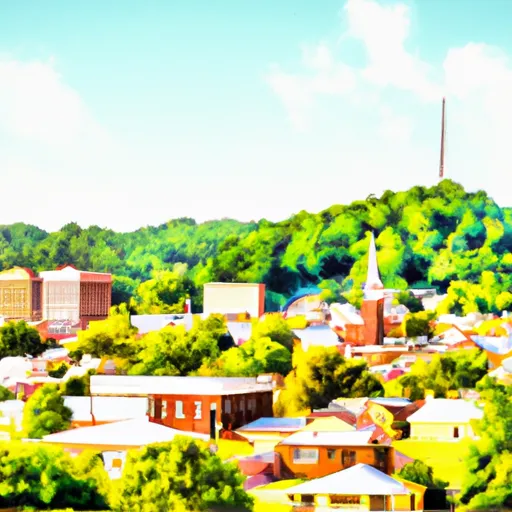-
 Snoflo Premium
Snoflo Premium
Get unlimited access to all our content
With no Ad interruptions! - Start Your Free Trial Login with existing account
Rogersville
Eden Index
Climate
8.3
•
Recreation
1.7
•
Community
1.9
•
Safeguard
4.4/10

Rogersville, Tennessee is a charming town located in Hawkins County, nestled in the northeastern part of the state. The climate in Rogersville is classified as humid subtropical, with hot, humid summers and mild winters. Average temperatures range from the mid-80s Fahrenheit in summer to the mid-40s in winter. The area experiences moderate rainfall throughout the year.
Hydrology constituents in Rogersville are abundant, with the Holston River flowing nearby. This river offers excellent opportunities for boating, fishing, and water sports. Anglers can catch a variety of fish species, including bass, catfish, and trout.
Outdoor enthusiasts will find ample recreational opportunities in Rogersville. The town boasts several parks and trails, such as the Rogersville City Park, Crockett Spring Park, and the Cherokee Lake Recreation Area. These provide spaces for picnicking, hiking, and enjoying nature's beauty. Additionally, nearby Cherokee Lake offers opportunities for swimming, boating, and camping.
In summary, Rogersville, Tennessee, offers a humid subtropical climate, with a moderate hydrology presence, including the Holston River. The town's outdoor recreation opportunities include fishing, boating, hiking, and enjoying parks and trails.
What is the Eden Index?
The Snoflo Eden Index serves as a comprehensive rating system for regions, evaluating their desirability through a holistic assessment of climate health, outdoor recreation opportunities, and natural disaster risk, acknowledging the profound impact of these factors on livability and well-being.
Climate Health Indicator (CHI): 8.3
Rogersville receives approximately
1117mm of rain per year,
with humidity levels near 84%
and air temperatures averaging around
14°C.
Rogersville has a plant hardyness factor of
7, meaning
plants and agriculture in this region tend to thrive during the non-winter months.
By considering the ideal temperature range, reliable water supplies, clean air, and stable seasonal rain or snowpacks, the Climate Health Indicator (CHI) underscores the significance of a healthy climate as the foundation for quality living.
A healthy climate is paramount for ensuring a high quality of life and livability in a region, fostering both physical well-being and environmental harmony. This can be characterized by ideal temperatures, reliable access to water supplies, clean air, and consistent seasonal rain or snowpacks.
Weather Forecast
Streamflow Conditions
French Broad-Holston
Area Rivers
French Broad-Holston
Snowpack Depths
French Broad-Holston
Reservoir Storage Capacity
French Broad-Holston
Groundwater Levels
Recreational Opportunity Index (ROI): 1.7
The Recreational Opportunity Index (ROI) recognizes the value of outdoor recreational options, such as parks, hiking trails, camping sites, and fishing spots, while acknowledging that climate plays a pivotal role in ensuring the comfort and consistency of these experiences.
Access to outdoor recreational opportunities, encompassing activities such as parks, hiking, camping, and fishing, is crucial for overall well-being, and the climate plays a pivotal role in enabling and enhancing these experiences, ensuring that individuals can engage in nature-based activities comfortably and consistently.
Camping Areas
| Campground | Campsites | Reservations | Toilets | Showers | Elevation |
|---|---|---|---|---|---|
| Sunburst | 10 | 3,230 ft | |||
| Ralph Andrews County Park | 47 | 3,578 ft | |||
| Burrells Ford | 9 | 2,044 ft | |||
| Mile Creek County Park | None | 816 ft | |||
| Chau Ram County Park | None | 780 ft | |||
| Keowee - Toxaway State Natural Area | 25 | 1,082 ft | |||
| Devils Fork State Park | 85 | 1,099 ft | |||
| High Falls County Park | None | 850 ft | |||
| South Cove County Park | None | 824 ft | |||
| Oconee State Park | 150 | 1,737 ft |
Nearby Ski Areas
Catastrophe Safeguard Index (CSI):
The Catastrophe Safeguard Index (CSI) recognizes that natural disaster risk, encompassing floods, fires, hurricanes, and tornadoes, can drastically affect safety and the overall appeal of an area.
The level of natural disaster risk in a region significantly affects safety and the overall livability, with climate change amplifying these risks by potentially increasing the frequency and intensity of events like floods, fires, hurricanes, and tornadoes, thereby posing substantial challenges to community resilience and well-being.
Community Resilience Indicator (CRI): 1.9
The Community Resilience Indicator (CRI) recognizes that education, healthcare, and socioeconomics are crucial to the well-being of a region. The CRI acknowledges the profound impact of these elements on residents' overall quality of life. By evaluating educational resources, healthcare accessibility, and economic inclusivity, the index captures the essential aspects that contribute to a thriving community, fostering resident satisfaction, equity, and social cohesion.

